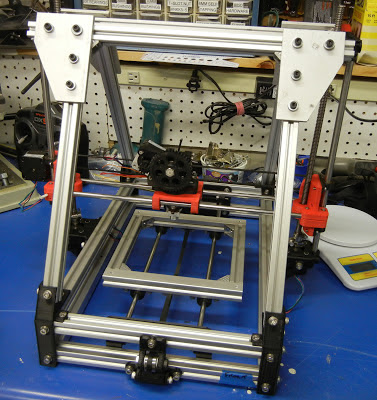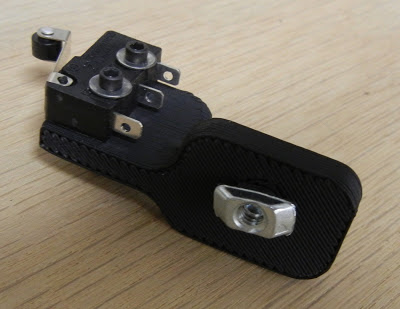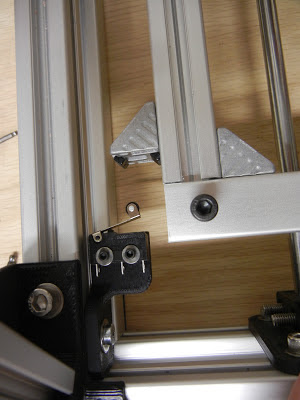Before I dove into mounting the endstop switches on my rep rap Mendelmax 1.5, I took the opportunity to salvage a 12v fan and power supply plug out of a dead PC power supply scavenged from my office's technology junk pile.
The power socket on the left will make adding a plug to my 12V power supply neat. The fan will probably be used to either cool the RAMPS electronics or be used on the X-axis slide to cool down the extruded material.
Next up was the mounting of the extruder to the X-axis slide. I didn't have the right M4 SHCS for the job, so I headed over to Lowe's. Being a standard hardware store, they didn't have a huge supply of metric hardware. But, they did have these M4 x 20 hex head screws, which actually worked perfectly.
 |
| M4 x 20 hex head screw inserted into the base of the extruder |
 |
| Extruder and hot-end finally bolted to the X-axis slide! |
Now it feels like I'm making some progress! The extruder and hot end are the heart and soul of the 3D printer. The RAMPS setup is the brain but I won't get into that in this post.
 |
| Lookin' good |
Next on the list- mounting the endstop switches. Every 3D printer has at least 3 endstop switches. One for each axis- X, Y, and Z- and during startup, the machine moves each axis to zero by moving the components until the endstop is triggered. This calibrates the machine and could correct for any drift in the steppers or movement when the machine is turned off. The "stock" endstop mounts are a bit cheezy, and I wasn't able to find anything "just right" on Thingiverse. Luckily we now have a Afinia 3D printer at work, so I was able to design and print new Y and Z axis endstop mounts. I ended up using the stock X axis mount, at least for now.
First, the Z-axis. The X-end mount (in red in the photo below) already had holes in it for the Z-axis mechanical endstop switch. These holes were the right size for a set of 2/56 SHCSs. But, there was no good way to attach anything for the switch to act against. I also wanted this endstop to be easily adjustable- this stop is particularly critical because it will allow for precision adjustment of the extruder nozzle over the print bed.
 |
| Z-axis switch mounted |
I noticed that the Z-axis motor mount support would be a great place to put a threaded hole- if it were only a bit wider. So I drew up a new bracket, printed it up on the Afinia, and vola. One adjustable mount perfectly positioned. I placed the
files on Thingiverse.com if anyone is interested in doing the same.
 |
| New Z-axis motor mount with integral Z-axis stop |
 |
| Z-axis endstop switch, actuated |
Next, the Y-axis. I chose to build a framed-in Y-axis slide using Bosch 80/20 style aluminum extrusions. This was easy and made a very stiff and solid Y-axis slide. It also provided a great place to put a endstop.
 |
| Front Right corner of the Y-axis slide, showing 90 degree bracket to be used as adjustable Y-axis endstop |
I designed and printed a switch bracket that put the switch in the right place. To finely adjust the endstop location, you can move either the switch bracket or the 90 degree bracket attached to the Y-axis slide, whichever is easier. The files for this part are also
now on Thingiverse.
 |
| Y-Axis switch bracket |
 |
| Y-Axis switch bracket |
 |
| Y-Axis endstop switch and bracket installed |
 |
| Y-axis bracket & switch installed, showing endstop activation |
 |
| 30,000 foot view of the completed Y-axis |
The mechanical assembly of the 3D printer is basically complete.There is the matter of construction the build platform, but that should be pretty simple- just a sheet of MDF or plywood on top of the Y-axis slide, and a sheet of glass cut to size.
Now into the unknown- wiring, programming, and setup of the RAMPS controller. Maybe first movement this coming weekend?
